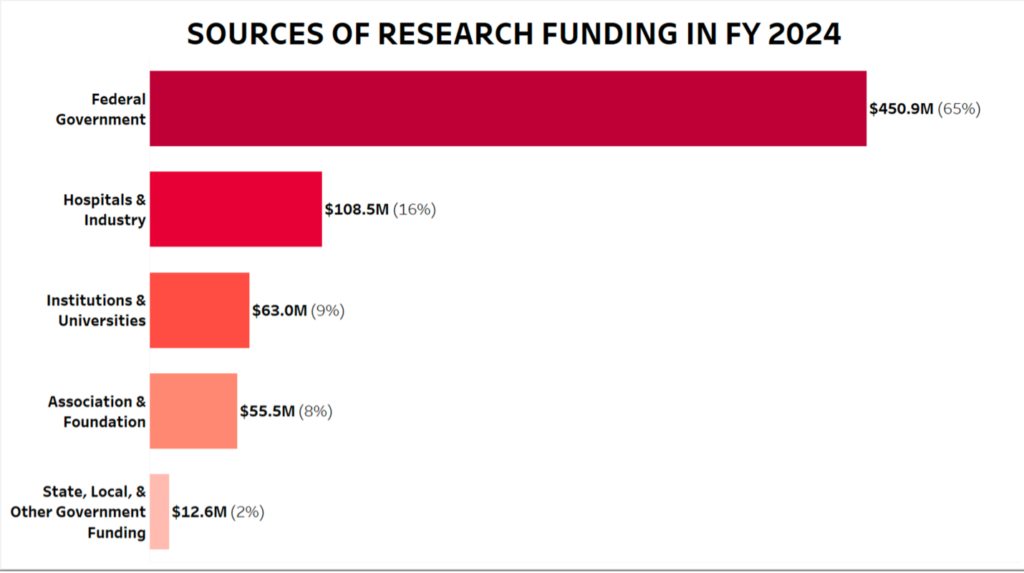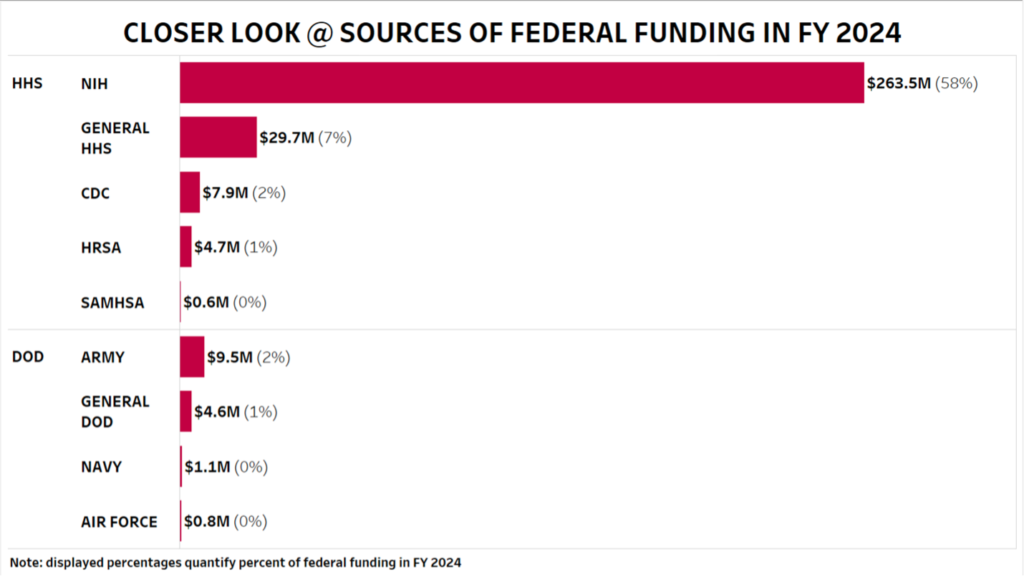Facilities and Administrative (F&A) rates are the mechanisms used to reimburse the University for the infrastructure costs (i.e. F&A costs associated with sponsored research and other sponsored agreements) related to research. F&A rates are essentially overhead rates, calculated as a percentage of the direct costs of sponsored projects, that are used to support and enhance campus-wide research performed by the University of Utah.
Contact Information: (801) 581-7236
Frequently asked questions around F&A cost reimbursements
-
F&A cost reimbursements, also known as “indirect costs,” are essential expenses for conducting research. These costs support the University of Utah in building and maintaining the research infrastructure needed for best-in-class results.
When the federal government awards a research grant, such as from the National Institutes of Health (NIH), the budget has typically included:
- Direct Costs (67-75% national average): These funds go directly to the research team to cover essential expenses such as salaries, graduate student support, equipment, and supplies.
- Indirect/F&A Costs (25-33% national average): These funds cover the infrastructure and operational expenses necessary for the research to take place.
F&A cost reimbursements support a wide range of critical resources, including:
- State-of-the-art research laboratories and equipment to carry out leading-edge science.
- Secure internet systems and high-speed data processing to carry out complex analyses.
- Compliance with national security protections and safety regulations for hazardous materials (e.g., human subjects protections, radiation safety and hazardous waste disposal, preventing undue foreign influence).
- Infrastructure to perform clinical trials for new medicines and treatments.
- Administrative and regulatory support, including grant management and reporting, to support research.
- Maintenance, utilities and staff required to sustain a safe and efficient research environment.
This infographic from the Council on Government Relations (COGR) illustrates many of the costs.
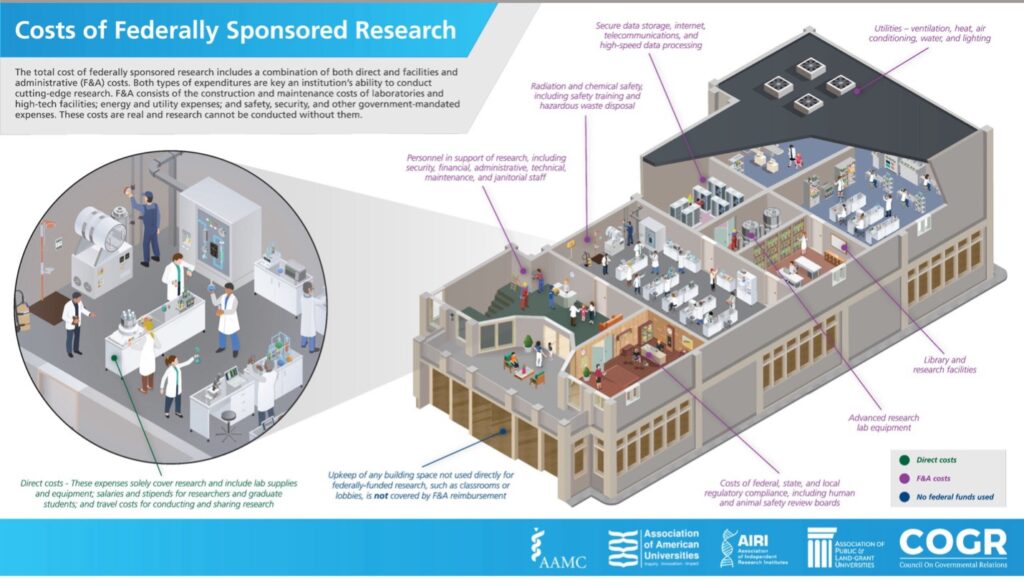
Infographic from the Council on Government Relations (COGR) about the costs of federally sponsored research.
Understanding the Real Costs of Research: learn more about the costs of research for work conducted on behalf of the federal government by universities. This short 5 minute video explains how Facilities & Administrative (F&A) costs work; video brought to you by: APLU, AAU, ACE, AAMC, COGR, and NACUBO.
-
F&A cost reimbursements are essential for covering research expenses. The federal government relies on universities, including the University of Utah, to conduct research in the national interest and to develop and maintain the necessary infrastructure to carry out this important work.
This research addresses national priorities in areas such as health and welfare, economic growth, and national defense. Performing research on behalf of federal agencies incurs a variety of expenses that would not otherwise exist for universities.
-
Cuts to F&A cost reimbursements are cuts to research. The National Institutes of Health has proposed a 15% F&A cap, which is projected to result in a loss of $50-70 million in research funding for the University of Utah this year alone. This reduction will have significant implications for the health and welfare of Utahns, Americans, the economy, and national security.
One U research innovation was featured during Super Bowl LIX, highlighting the national importance of the U’s groundbreaking work. A motorized limb covered with a silicone “skin” called the LUKE arm, named after the robotic hand that Luke Skywalker receives in the movie “The Empire Strikes Back” allows amputees to feel a sense of touch and move the prosthetic with their thoughts.
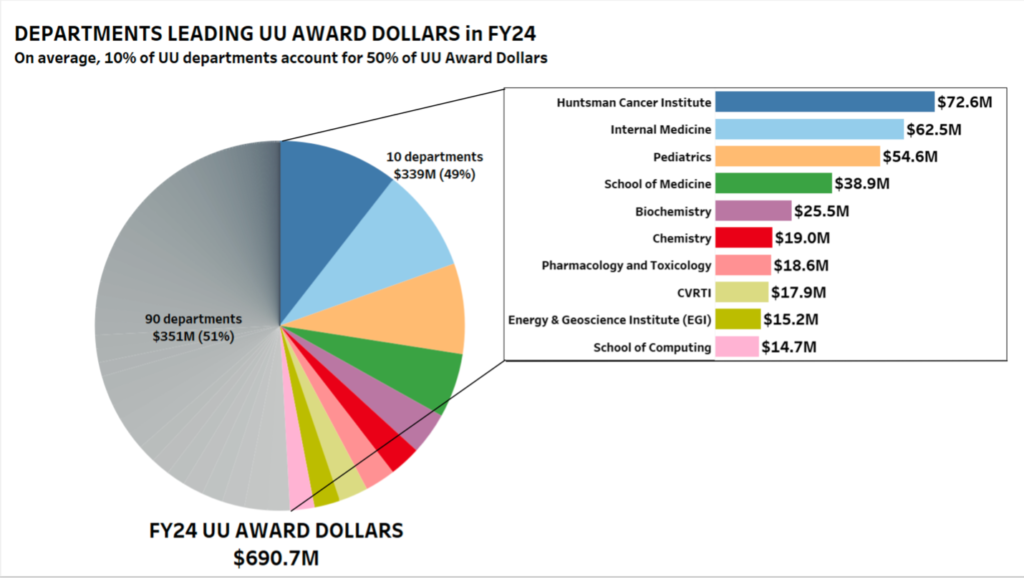
A Pfizer commercial touted cancer research and breakthroughs—which Huntsman Cancer Institute and many other Utah sectors are regularly recognized for.
Imagine if companies like Pixar, Adobe, Atari, and biotechnology companies like Myriad Genetics, and Biofire—rooted in Utah’s university research—never came about because of limited research funds.
In general, a reduced F&A cost reimbursement will impact:
- The university’s capacity to carry out leading-edge research to meet the needs of people in Utah and the nation.
- The capability to build and maintain facilities required for research.
- Support for staff and infrastructure, which could result in layoffs and impact the safety of patients, researchers, and students.
- Training and education opportunities for the next generation of scientists and engineers.
- The university’s ability to keep student tuition rates low.
-
No, the University of Utah does not financially profit from F&A cost reimbursements. As defined by the federal government, these funds are reimbursements for costs incurred by universities while conducting research on behalf of the government and cannot result in profit.
In fact, universities, including the University of Utah, are not fully reimbursed for the expenses required to support federally funded research. This shortfall is due to a cap imposed by the Office of Management and Budget (OMB), which limits how much the government can reimburse universities for administrative and compliance related expenses, including federal mandates.
F&A reimbursement costs are essential to offsetting the significant investments universities make in maintaining the infrastructure and support systems required for high-quality research, but they do not cover all costs. In FY24, the U contributed $154 million in facilities and administrative expenditures.
-
No. F&A cost reimbursements recovered by research institutions have remained flat for over 20 years.
-
No. OMB rules (2 CFR Part 200 - Uniform Administrative Requirements, Cost Principles, and Audit Requirements for Federal Awards)) require that F&A cost reimbursement rates only be based on research facilities, operations, and support used by federally funded research, and not for education or other university facilities or activities.
-
The F&A reimbursement rate determines the amount the University of Utah is reimbursed for indirect costs on research grants. Every 2 to 4 years, the agency responsible for setting a university’s F&A cost rate (such as the Department of Defense Office of Naval Research or the Department of Health and Human Services) will comprehensively audit and/or assess these shared costs to determine the appropriate federal reimbursement rate. This process determines the appropriate federal reimbursement rate, based on specific costs deemed allowable by the OMB.
This standardized rate is applied uniformly across all eligible research grants, streamlining the reimbursement process.
-
F&A reimbursement rates differ across institutions due to variations in infrastructure, location, and operational needs.
Federal officials and university administrators predetermine an overall percentage of allowed F&A cost reimbursements by examining documented historical costs and conducting cost analysis studies. The final rates for F&A expenses are established after a rigorous review and audit of the actual funds previously spent for such costs.
These rates vary from institution to institution because of construction, maintenance, age of facility, utilities, and administration costs vary by region. For example, the F&A cost reimbursements for a biomedical research facility built in an urban area that experiences earthquakes is different than an engineering research facility built in a rural area

Federal Facilities and Administrative (F&A) cost reimbursements and their impact on University of Utah research
The University of Utah is a leading research institution both in Utah and the nation. Our faculty, staff, and students carry out research that significantly impacts the daily lives of people in our state, country, and world through innovation, groundbreaking discoveries, and new treatments and cures.
A substantial portion of the U’s $691 million annual research comes from federal agencies that support research activities across various disciplines such as life and health sciences, engineering, computer and information sciences, and physical and social sciences. This research is addressing a range of issues, from developing new treatments for heart failure to creating software that protects wildland firefighters.
Recently, the government has brought attention to facilities and administrative (F&A) cost reimbursements associated with research grants. F&A cost reimbursements are necessary for developing and maintaining research operations and infrastructure that are integral to advancing research. Reducing this core support would have real consequences in our state and nation. It would slow the pace of science resulting in longer waits for treatments and solutions to society’s most pressing challenges. It would harm the economy by jeopardizing the livelihoods of people across Utah and the U.S. Strong, continued support for research is essential to the future of our country.
